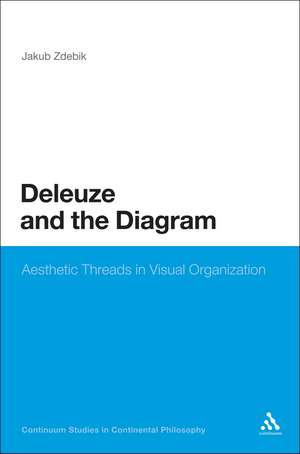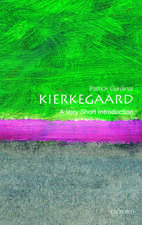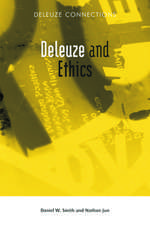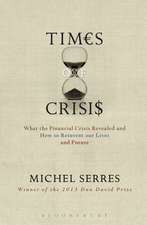Deleuze and the Diagram: Aesthetic Threads in Visual Organization: Continuum Studies in Continental Philosophy
Autor Dr Jakub Zdebiken Limba Engleză Hardback – 30 mai 2012
| Toate formatele și edițiile | Preț | Express |
|---|---|---|
| Paperback (1) | 237.75 lei 6-8 săpt. | |
| Bloomsbury Publishing – 15 ian 2014 | 237.75 lei 6-8 săpt. | |
| Hardback (1) | 891.10 lei 6-8 săpt. | |
| Bloomsbury Publishing – 30 mai 2012 | 891.10 lei 6-8 săpt. |
Din seria Continuum Studies in Continental Philosophy
- 23%
 Preț: 179.10 lei
Preț: 179.10 lei - 31%
 Preț: 890.14 lei
Preț: 890.14 lei - 23%
 Preț: 262.25 lei
Preț: 262.25 lei - 31%
 Preț: 890.55 lei
Preț: 890.55 lei - 22%
 Preț: 949.17 lei
Preț: 949.17 lei - 14%
 Preț: 1007.12 lei
Preț: 1007.12 lei - 31%
 Preț: 889.88 lei
Preț: 889.88 lei - 22%
 Preț: 1007.12 lei
Preț: 1007.12 lei - 22%
 Preț: 888.58 lei
Preț: 888.58 lei -
 Preț: 256.02 lei
Preț: 256.02 lei - 22%
 Preț: 949.17 lei
Preț: 949.17 lei - 22%
 Preț: 948.91 lei
Preț: 948.91 lei - 22%
 Preț: 948.66 lei
Preț: 948.66 lei - 31%
 Preț: 891.51 lei
Preț: 891.51 lei - 22%
 Preț: 948.34 lei
Preț: 948.34 lei - 22%
 Preț: 256.49 lei
Preț: 256.49 lei - 14%
 Preț: 946.53 lei
Preț: 946.53 lei - 31%
 Preț: 890.72 lei
Preț: 890.72 lei - 14%
 Preț: 1005.98 lei
Preț: 1005.98 lei - 14%
 Preț: 889.88 lei
Preț: 889.88 lei - 14%
 Preț: 947.54 lei
Preț: 947.54 lei - 31%
 Preț: 947.54 lei
Preț: 947.54 lei - 22%
 Preț: 1005.41 lei
Preț: 1005.41 lei - 22%
 Preț: 947.11 lei
Preț: 947.11 lei - 23%
 Preț: 255.94 lei
Preț: 255.94 lei - 31%
 Preț: 948.34 lei
Preț: 948.34 lei - 22%
 Preț: 947.54 lei
Preț: 947.54 lei - 22%
 Preț: 946.53 lei
Preț: 946.53 lei - 22%
 Preț: 947.54 lei
Preț: 947.54 lei - 22%
 Preț: 889.39 lei
Preț: 889.39 lei - 22%
 Preț: 257.50 lei
Preț: 257.50 lei - 22%
 Preț: 1005.41 lei
Preț: 1005.41 lei - 31%
 Preț: 889.88 lei
Preț: 889.88 lei - 31%
 Preț: 947.94 lei
Preț: 947.94 lei - 22%
 Preț: 947.11 lei
Preț: 947.11 lei - 22%
 Preț: 947.86 lei
Preț: 947.86 lei - 14%
 Preț: 891.51 lei
Preț: 891.51 lei - 22%
 Preț: 948.10 lei
Preț: 948.10 lei - 31%
 Preț: 891.36 lei
Preț: 891.36 lei - 22%
 Preț: 1005.72 lei
Preț: 1005.72 lei - 31%
 Preț: 888.97 lei
Preț: 888.97 lei - 14%
 Preț: 947.54 lei
Preț: 947.54 lei - 19%
 Preț: 373.30 lei
Preț: 373.30 lei - 11%
 Preț: 373.30 lei
Preț: 373.30 lei - 22%
 Preț: 1007.62 lei
Preț: 1007.62 lei - 22%
 Preț: 1005.72 lei
Preț: 1005.72 lei - 22%
 Preț: 946.53 lei
Preț: 946.53 lei - 22%
 Preț: 948.34 lei
Preț: 948.34 lei
Preț: 891.10 lei
Preț vechi: 1036.16 lei
-14% Nou
Puncte Express: 1337
Preț estimativ în valută:
170.53€ • 174.64$ • 141.86£
170.53€ • 174.64$ • 141.86£
Carte tipărită la comandă
Livrare economică 18 martie-01 aprilie
Preluare comenzi: 021 569.72.76
Specificații
ISBN-13: 9781441115607
ISBN-10: 1441115609
Pagini: 256
Dimensiuni: 156 x 234 x 25 mm
Greutate: 0.54 kg
Ediția:New.
Editura: Bloomsbury Publishing
Colecția Continuum
Seria Continuum Studies in Continental Philosophy
Locul publicării:London, United Kingdom
ISBN-10: 1441115609
Pagini: 256
Dimensiuni: 156 x 234 x 25 mm
Greutate: 0.54 kg
Ediția:New.
Editura: Bloomsbury Publishing
Colecția Continuum
Seria Continuum Studies in Continental Philosophy
Locul publicării:London, United Kingdom
Caracteristici
Expands Deleuze's diagram into a complete visual theory through Foucault, Lyotard, Simondon, Heidegger and Kant.
Notă biografică
Jakub Zdebik teaches at the University of Ottawa, Canada.He received his PhD from The Centre for the Study of Theory and Criticism at The University of Western Ontario.
Cuprins
Preface \ Introduction: What is a Diagram? \ 1. Constraintand System as Vegetation: Diagram and Visual Organization \ 2. Black Line WhiteSurface \ 3. Gilles Deleuze's Diagram (Complicated by a Comparison to ImmanuelKant's Schema) \ 4. The Extraordinary Contraction \ 5. Skin, Aesthetics,Incarnation: Deleuze's Diagram of Francis Bacon-An Epilogue \ Notes \ Bibliography \ Index
Recenzii
'A magnificent treatment of the relation of the diagram to what Deleuze calls le devenir: For Zdebik the diagram, like the fold, is a creative function that shapes the entirety of the philosopher's writing.It is a hybrid machine, an amphibious device, an elastic mechanism in which geography and anatomy, like art and science or form and force, are of the same order.Zdebik offers a clear, compelling, indeed dazzling reading of a body of work integral to what John Bender and Michael Marrinan have astutely called the culture of diagram.Thanks to this book we can now see how and why Deleuze excels in areas that extend from philosophy to cinema, from geology to biology, from literature to topology, and from painting to poetry. The author brings us a rich, sensuous, and decisive contribution that stands high and strong in the industry of Deleuze studies.'
'Finally, a book has arrived that brilliantly delineates how the diagram indirectly reveals the untraceable, yet mappable, philosophical system of Deleuze and Guattari. Zdebik delicately explains the diagram's dynamism, productive constraints, and its abstract and material dimensions.Drawing on a philosophical lineage stretching from Kant to Heidegger, Foucault and Simondon, as well as examples from natural history, architecture, and contemporary art, the diagram's hybridity and, ultimately, its carnality for Deleuze in his study of Francis Bacon, is masterfully displayed. This is a bold work of transdisciplinary scope that rightfully places the diagrammatic at the core of Deleuzean philosophy.'
'Zdebik's book fills handsomely a glaring gap in the literature on diagrammatic thinking in general and the role the diagram plays in Gilles Deleuze's ontology and aesthetics. It is thoughtful, well written, informative and will be of immense interest to those who want to understand the recent prominence of diagrammatic thinking and the way in which it rivals semiotic thinking. It will also show Deleuze scholars how exactly the diagram-a concept at the center of Deleuze's work-was meant to work.'
'Finally, a book has arrived that brilliantly delineates how the diagram indirectly reveals the untraceable, yet mappable, philosophical system of Deleuze and Guattari. Zdebik delicately explains the diagram's dynamism, productive constraints, and its abstract and material dimensions.Drawing on a philosophical lineage stretching from Kant to Heidegger, Foucault and Simondon, as well as examples from natural history, architecture, and contemporary art, the diagram's hybridity and, ultimately, its carnality for Deleuze in his study of Francis Bacon, is masterfully displayed. This is a bold work of transdisciplinary scope that rightfully places the diagrammatic at the core of Deleuzean philosophy.'
'Zdebik's book fills handsomely a glaring gap in the literature on diagrammatic thinking in general and the role the diagram plays in Gilles Deleuze's ontology and aesthetics. It is thoughtful, well written, informative and will be of immense interest to those who want to understand the recent prominence of diagrammatic thinking and the way in which it rivals semiotic thinking. It will also show Deleuze scholars how exactly the diagram-a concept at the center of Deleuze's work-was meant to work.'




























